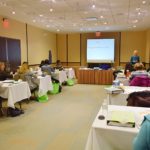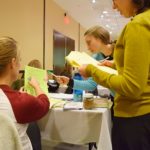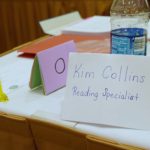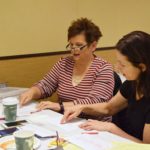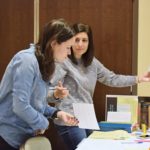This particular day is Day 3 of the week’s curriculum, and after an initial meet-and-greet and ample coffee, about 20 educators got comfy in their seats.
Among the group is Chicago Public Schools teacher Megan Sechowski, an educator of 16 years teaching seventh-grade, who, until this year, had been specializing in music administration. Now in her first year teaching special education, Sechowski said she’d been looking for a way to truly “connect” with some of her students who have severe challenges to learning, like dyslexia, ADHD, language barriers and difficult home situations.
As seventh-graders, Sechowski said her students’ reading abilities vary from non-existent to about the third or fourth-grade level. Though she’s experienced students reading slightly below grade level in the past, her students this year are experiencing unique struggles that affect their reading in a way Sechowski said she’s never experienced.
“I need the skill set, I need to be able to connect with them some way,” she told the Journal. “As special education students, there can be an expectation that if they’re at the status quo, they’re doing well. But I don’t want them to be the status quo, I want to see growth.”
Having “tried everything,” Sechowski said during training she could already tell IMSE’s Orton-Gillingham would translate back in her classroom. In particular, Sechowski speculated her hyperactive students would engage well with IMSE’s multi-sensory approach by keeping their attention focused through learning activities.

Megan Sechowski, right, is a seventh-grade special education teacher in Chicago looking for ways to meet the needs of her students.
Sechowski said the choice to go through IMSE’s Orton-Gillingham training was easy: any teacher at Frank W Reilly School, where Sechowski works, can take the class for free — and many have. At Reilly, the majority of teachers who would benefit from IMSE’s Orton-Gillingham training have taken advantage of the fact the school will pay for it because they know the training works, she said.
The Chicago teacher said she’s also taking the class for personal reasons: as a mom to two, she’s been looking for better ways to engage her own child with ADHD when it comes to reading.
The Trainer
Trainer Kim Collins said she remembers the moment she knew she wanted to educate other teachers on IMSE.
As a teacher in 2009, Collins said she was a reading specialist looking to put more tools in her tool kit. She and a colleague took a course with the Institute for Multi-Sensory Education and Collins was instantly hooked.
“I looked to her said, ‘Oh my gosh, one day, we are going to train this,'” Collins told the Journal.
She kept the idea in the back of her mind for several years until she reached a point in her career and personal life about a year and a half ago that she could finally make the switch from IMSE Orton-Gillingham user to IMSE Orton-Gillingham trainer.
“I saw how successful it was from using it with students,” Collins said. From those in the general education population, to special ed, to English Language Learners and all in between, Collins said she knew from experience IMSE’s Orton-Gillingham was something she could stand behind because she watched it work in action.

Trainer Kim Collins first learned of IMSE as a teacher, but quickly latched on and had hoped to become a trainer.
When she’s not teaching educators how to use IMSE’s Orton-Gillingham, Collins, an alum of North Carolina’s Appalachian State University and American College of Education in Indiana, said she’s working for her home state’s education agency and spending time with her family.
Overall, it’s been great to be able to spread her passion for teaching and IMSE to others, she said.
“I’ve seen how it impacts all kids,” she said. “I really feel like it’s the best training.”
The Class
To start the day’s events, Collins warmly welcomed the class and, after going over the day’s agenda, reviewed the previous night’s assignment and spent time answering questions from the group.
Once homework and questions were addressed, Collins swiftly moved straight into the day’s lessons: blending, arm-tapping, assessments, breaking up syllables and much more. By using an overhead projector and walking throughout the room, Collins worked through practice lessons in both demonstration and group practice, preparing for team and group work later on in the afternoon.
Step-by-step, teachers not only worked through the same materials their students would, but paired with each other to practice and gather feedback on implementing the techniques with students. All the while, educators taking the class sprinkled Collins’ lesson with their own supportive anecdotes, tips and tricks, and shared from personal experience — or, as Collins put it: “We get our best ideas from each other.”
After an hour for lunch, the day continued by working through IMSE’s training books: “Comprehensive Syllable Division Word Book,” “Recipe for Reading Manual,” the essential green flip book, and master binder, ultimately culminating in small group practice lesson plans that incorporate the day’s concepts.
Check out more photos of the day below, and to learn more about training with the Institute for Multi-Sensory Education, look here.
- Arm-tapping out a word in partners.
- Trainer Kim Collins demonstrating blending boards.
- A look at an IMSE class.
- Blend workshopping.
- New teachers meeting and working together.
- Using a multi-sensory approach to literacy.
- The day culminates in a group lesson plan.
- Trainer Kim Collins was an IMSE-trained teacher before becoming a trainer.
- Teachers not only learn new skills, they have fun doing it.
- Teachers work in pairs and groups to become proficient in IMSE throughout the training.
- Educators easily follow along with the instructor.
- Drawing out red words.
- Extra materials for teachers to utilize.
- The desk of a teacher in training.



